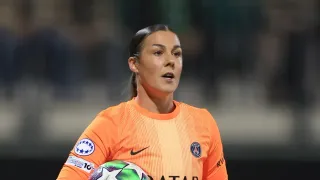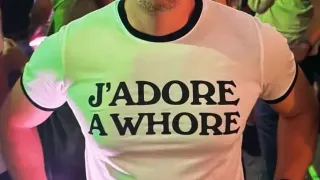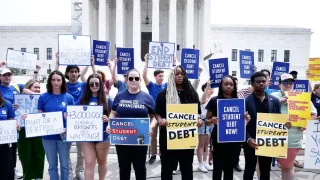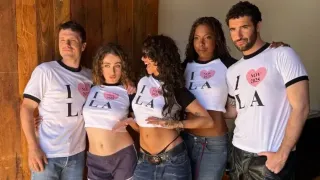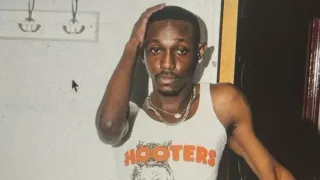June 21, 2022
Frameline's Finest Films, and a Few Flubs
Brian Bromberger READ TIME: 21 MIN.
When asked what themes she saw emerging from the vast number of films being shown at Frameline46, Director of Programming Allegra Madsen replied, "An exploration of our queer lineage through time, such as 'Nelly & Nadine' and 'Jimmy in Saigon' speaking to unearthing secret family histories."
She added what our place in the world will be in light of the rise of repressive regimes, such as in "Three Tidy Tigers Tied a Tie Tighter" and "Mars One." But building on that insight, we witness characters arising out of the ashes of some crisis whether it be political, social, or emotional, with films in this category including "Uyra," "Black As U R," "El Houb-The Love," "Moneyboys"," Follow the Protocol," "Sissy," "So Damn Easy Going," "Wandering Heart," "Where Butterflies Don't Fly," "Jeannette," and "A Run For More."
What we also observe is the use of unearthed letters and diaries to fill in the gaps of formerly silent and/or silenced history, and in doing so, attempts to discover queer connections with past generations, which is found not only in "Nelly & Nadine" and "Jimmy in Saigon," but also in "Loving Highsmith," "Framing Agnes," "Ultraviolette and the Blood-spitters Gang," and to a lesser degree, "All Man: The International Male Story" and "Boulevard! A Hollywood Story."
2022 might also be called the Year of Drag, since that art form is central to numerous films, such as "Last Dance," "Donna," "Cut," "Sixth Reel," "Finlandia," "The Unabridged Mrs. Vera's Daybook," "Fashion Babylon," and "Uyra." Each explores history but offers hints where a future may lie. But whatever themes viewers might detect, they are all seen through the prism of a collective queer voice that is becoming more diverse and bolder as Frameline soon approaches its half-century mark.
If you like your men on the grimy side, we can heartily recommend the British gay rugby film "In From the Side." The South London Stags is divided into two teams, squads A and B, a boundary not to be crossed, until Mark (Alexander Lincoln) from squad B has a fling with Warren from squad A (Alexander King) after a drunken soiree.
They are both in committed partnerships, albeit unhappy ones, so no one can find out about their full-blown affair, since it has the potential to destroy the club they both love. Mark will even take Warren on a Christmas holiday to Aspen to meet his parents, his mother urging caution, while his father advises that life's too short not to miss a fun opportunity.
Lincoln and King have an undeniable chemistry and there are numerous scenes of men writhing in the mud. Sexy and homoerotic, yet the ending seems almost inevitable and is heavy on melodrama. Still, "In From the Side" is absorbing and hot, even if their sweaty erotic encounters will involve collateral damage; a guilty pleasure worth indulging.
A brooding and magnificently photographed Ireland is the setting for "It is in Us All," about an urbane London businessman who return to his roots and visit the house bequeathed to him by his late aunt, which was also his mother's childhood home. Hamish (Cosmo Jarvis) works for his father's production company based in Hong Kong. He leaves a voice message while driving, then is involved in a car crash which kills 15-year-old Callum. Though not charged with the accident, he gets acquainted with Evan (Rhys Mannion), the 17-year-old friend who escaped the crash unharmed.
Evan (who we learn was driving the car rather than Callum) develops a crush on Hamish, who is drawn to him not so much sexually but more as a way to try to connect to the home which his mother had tried to return to when she fled his father, with whom Hamish has a distant relationship. Hamish wants to fill in the history about his long dead mother whom he barely knew.
What director Antonia Campbell-Hughes does so well is establish a sense of place and community. The isolated countryside almost becomes a character in itself. If only she had exercised similar precision with the screenplay, which is defuse, vague, and leaves too many unanswered questions. The ending is too muted. Jarvis has a commanding screen presence but seems hampered by the obscure circumstances he finds himself. A striking moody Gothic ambiance is wasted on an unfulfilling drama.
Australia has rarely seemed so sexy in the drama "Lonesome," in which country boy Casey (Josh Lavery) flees a small-town scandal and escapes to Sydney to start a new life and find himself. Through a threesome he located on Grindr, he meets Tibi (Daniel Gabriel) and after a successful amorous connection he winds up staying at his apartment. They work together for cash in a series of odd jobs. An effective team, they grow closer as both are alone in the world.
Tibi is saving money so he can pay for a visa for his deported mother, while Casey reveals he had an affair with a married man who eventually ended his own life after the town discovered their secret. Casey's mom warns him not to return. He has withstood both physical and psychological abuse. Can the couple overcome their scars and build a life together?
This is a story that has been told many times, but newcomer Josh Lavery with his James Dean-like looks, hurt, and vulnerability, gives a star-making performance and puts in his potential bid as the next Heath Ledger. Both he and Gabriel (a Sudanese/Egyptian performer) are openly queer.
Midway there is a stunning scene when the couple are making repairs in Carol's (Ann Finsterer) house, with her talking to Casey how Tibi reminds her of her estranged son. Finsterer gives a four- minute Master Class in Acting, proving Stanislavski's dictum, "There are no small parts, only small actors."
Lavery is nude for at least half of the film, often in explicit scenes, but we promise you won't mind at all. He is the heart-throb who will break your heart. This standard fare is raised by top-notch performances and a brooding melange of characters searching for connection, despite carrying scars of individual traumas. While not entirely deserved, it's one of the highlights of the festival.
A spellbinding detective story, the documentary "Jimmy in Saigon" explores the mysterious death, countercultural life, and forbidden romance of a 24-year-old Vietnam veteran who died in Saigon in 1972. Jimmy's rejection of his family's 1950s values and his eventual demise –noted on his death certificate as a heroin overdose– created a veil of sadness over the family for decades.
Director Peter McDowell, Jimmy's younger brother, who was only five years old when Jimmy died, wants to piece together the secrecy and mystery, beginning a ten-year search to uncover the truth behind Jimmy's sexual orientation and drug use. His journey takes him to Saigon, where Jimmy, after finishing his army stint, willingly returned and wanted to live there permanently.
How exactly did Jimmy die and did he have a girlfriend or a younger male Vietnamese lover? And how after uncovering Jimmy's struggles, will it affect Peter's understanding of his own identity as a gay man? Using lots of letters written by Jimmy, interviews with family members (especially their surviving mother), and people who knew Jimmy, can Peter resurrect the last year of Jimmy's life? With gay sex columnist/author Dan Savage as executive producer, "Jimmy in Saigon," is one of the heart-wrenching gems of Frameline46, not to be overlooked.
An elongated video performance gorgeously filmed, Brazil's "Uyra: The Rising Forest," stars Uyra, a nonbinary trans indigenous artist, the alter-ego of Emerson, a biologist and art educator, whose persona defines themselves as a "tree that walks." With Uyra the viewer travels through the Manaus Rainforest in the Amazon as they use performance art to teach indigenous youth they are the guardians of ancestral messages of the Amazon forest called to protest deforestation as well as raise awareness of other environmental issues.
In a country that kills the highest number of trans, indigenous, and environmentalist youth worldwide, Uyra makes the connection that the destruction of the ecosystem is the same violence perpetrated against LGBTQ people. Using astounding makeup, drag costuming, and camouflage as well as choreographed dances, the video performances are hypnotic. Uyra is literally allowing us to hear the Amazon speak for itself.
The videos are so phenomenal they overshadow the slightly tedious sermonettes about structural racism and how we are destroying the ecosystem, in which Uyra preaches to the choir. Still, the film is unique as a living workshop in the forest. Although only about an hour long, the film blurs the lines and boundaries that divide the documentary and fiction, as we are transported to the ancestral Amazonian enchanted world. This is a journey well worth taking.
Drag can become a drag is the message behind the documentary "Last Dance," the story of iconic drag queen/mother, the gender-bending Lady Vinsantos, who rules New Orleans and runs the famous New Orleans Drag Workshop, a finishing school for new performers. The company's philosophy is that drag transforms people, because wearing a mask they are given the license to be someone else. Lady Vinsantos is the brainchild of cabaret artist Vincent DeFonte, who launched his career at San Francisco's Trannyshack before relocating to New Orleans.
After 30 years Vincent is tired of the character that has taken over his life. He decides to say good-bye to Lady Vinsantos by realizing his greatest dream: one last show in Paris with the hope maybe he can fall in love with drag again. The film follows him for six months as he prepares for his farewell appearance, bringing along some trans luminaries who will also sing in the show.
Not surprisingly, Vincent is a control freak, fortunately steadied by his long-time romantic partner and manager. His snarky routine is aided by performances from very talented younger drag artists, some of them graduates of the Workshop.
One fascinating subplot is the latest trend stories of cis women who want to perform in drag. Can Vincent reach a new creative peak as he bows out? It's all okay, but the finale is not the showstopper you might be expecting. Vincent is also critical of how "RuPaul's Drag Race" has commercialized what was once done for art alone. The tone here is elegiac. It grabs your attention, even as you realize Lady Vinsantos is passing the torch to a younger generation.
As if the world doesn't have enough problems now, aliens are back in the quirky road movie "Unidentified Objects." Peter (Matthew Jeffers) is a gay curmudgeon, an unemployed Chekhov-loving dwarf suspicious of his neighbors. One night he is approached by Winona (Sarah Hay), a sex worker, who lives in the same building, who tries to talk him into lending her his car so she can drive to Canada. Peter is initially repelled, but, when she offers to pay him, he relents – as long as he can accompany her.
Peter had a woman friend who killed herself and, not taking her pain seriously, didn't intervene, for which he now feels guilty. He wants to stop at a beach she had long wanted to visit. Winona's reason for traveling is that many years ago she claimed she was abducted by aliens, and now they've contacted her again, instructing her as to where to meet them so they can take her away permanently.
Peter thinks she's delusional, but comes to understand this trip has emotional resonance for her and reluctantly agrees to follow along. As in any road movie, Peter is slowly transformed on his trek of self-discovery as he processes his grief and opens up emotionally, willing to let the world in a bit more. The film has tinges of "Close Encounters of the Third Kind." Assuming you buy into the premise, it works on its own limited terms, mainly due to the terrific acting of Jeffers and Hay, both individually and in tandem, despite bordering on the bitter dwarf stereotype. The film is a modest success, enticing in its eccentricity.
Ghosts of the friendly kind haunt Chile's narrative "Phantom Project," which introduces us to Pablo, a gay 30-year-old actor who dreams of starring in a film. To pay the rent he has odd acting jobs, like working as a mock patient in medical school class reenactments and weird sessions of alternative therapies. He's still in love with his ex-boyfriend, a rising YouTube star, frustrated that his acting career is stalled, and his flighty roommate is moving out, leaving behind two months unpaid rent, a cute dog named Susan, a cardigan sweater, and, yes, a ghost, which may account for unexpected noises and occasional breakages in the apartment.
The ghost is depicted as a squiggly line drawing that is connected to the cardigan. It sounds creepy, but the poltergeist is mostly benign and seems to want the best for the sweet-natured Pablo, helping him meet new friends and maybe even giving his career a spectral boost in the right direction.
It's the type of innovative film you are rooting to be great, but isn't. It has long dull patches, and the plot strains credulity. It's unsubstantial, but, in its favor, it vividly portrays that transition into one's 30s, when you are dealing with failed relationships and unfulfilling jobs, yet still want success, knowing time is running out. By no means a disaster, the film is likable, even endearing in spots, but in the final analysis it's a squandered opportunity.
"Two gay men get trapped in a cave" sounds like the beginning of a joke, but it couldn't be more real than in the Czech Republic tense drama "Where Butterflies Don't Fly." Daniel (Daniel Krejcik) is an 18-year-old senior, who has quarrelling parents and no friends. He recognizes he is different from other guys, but isn't interested in fitting in with the status quo, and he has little desire to study and prepare for his graduation. On a senior camping trip, he falls into a hidden cave, followed soon after by his literature and gym teacher, Adam (Jiri Vojta), who is gay and lives secretly with his younger partner, David.
This is another road movie, as Daniel and Adam, lost in the darkness and cut off from the rest of the world, must journey through the cave and find a way out. They challenge each other, with Daniel wondering why Adam isn't more forthcoming about his sexuality at school and Adam asking why Daniel is always alone. If you suffer from claustrophobia, this movie isn't for you.
Aside from being naked in a sleeping bag to keep each other warm in the freezing-cold cave, there's nothing inappropriate going on between teacher and student. Both handsome Krejcki and Vojta are superb, having to be the sole actors, alone on screen for an hour and a half. At slightly over two hours, the film is too long, but it's an effective commentary on the loneliness of being a gay teen. It never quite rises to thrilling, but mostly grabs your interest, with the forbidding majestic cave being the real star here.
If you are feeling depressed and need some cheering up, then make a beeline for the exhilarating documentary "The Unabridged Mrs. Vera's Daybook," about two brilliant San Franciscan artists, photographer Michael Johnstone and costumer David Faulk (who plays Mrs. Vera), both long-term AIDS survivors. After becoming a couple in the early 1990s, to deal with their collective grief they decided to invent together new, joyful, and incredible art out of immeasurable loss to celebrate the creativity of people who didn't survive the HIV pandemic.
Johnstone almost lost his sight to CMV retinitis and practically died three times. They developed Mrs. Vera's Daybook, a vibrant collection of photos they started taking in Golden Gate Park. Mrs. Vera is a drag tornado, steeped in camp but garishly decorated with thrift store materials, recycled objects, and dollar store plastics "to construct whimsical, outrageous and explosively colored costumes" for an eccentric, but heartwarming, character.
As Visual Aid artists, they started appearing at Pride Parades, street fairs, and other public events, joined by a group of supporters known as the Verasphere, who travel en masse from all over the country with crazy costumes often designed by Faulk, becoming "ambassadors of good cheer" and spreading jubilation. They want to promote the message to those living with HIV not to be afraid –�to get back out into the world and have some fun.
Mrs. Vera was a grand marshal at the 2019 Pride parade, and both men recently finished a mural on long-term LGBTQ elderly AIDS survivors for Openhouse at 55 Laguna. The only question they ask is, How can they make people happy and express gratitude for being alive? "Why shouldn't you be who you want to be?" The explosive, extravagant colors almost jump off the screen. One of the true magical delights of the festival, this jewel of a film will almost have you floating with joy out of the theater.
At first, the Canadian narrative "You Can Live Forever" feels as if it could be a lesbian TV after-school special, especially since it's supposed to occur in the early '90s. After the death of her father and her mother's subsequent breakdown, Jaime (Anwen O'Driscoll) is sent to live with her aunt and uncle, who are devout Jehovah's Witnesses. Nonbeliever Jaime strikes a spark with Marike (June Laporte), the daughter of a Witness elder. Slowly, they form a tender romance, and halfway through we've gone from weeknight Bible Study groups to frottage.
It's only a matter of time before the community discovers their secret. What is refreshing about the film is that the Jehovah Witnesses are not demonized (with some of the characters more sympathetic to Jaime and Marike's plight than others), and Marike is presented as someone who's aware she's lesbian, and in her own tortured mind is trying to reconcile her religion with her sexuality.
There is little doubt about which side, in the conflict between faith and love,is going to be the victor. O'Driscoll and Laporte have a lovely rapport, and their relationship feels like an authentic high-school romance. We loved the bouncy, upbeat score by Canadian musician CFCF. It's a sensitive, thoughtful, if sad feature from debut filmmakers Mark Slutsky and Sarah Watts, the latter a lesbian who grew up in a Jehovah Witness household. A minor, if at times amateurish, and understated production, the film succeeds in that audiences will care about Jaime and Marike, so a definite thumbs up.
Messiness abounds in the insipidness that is "My Fake Boyfriend," which was probably meant as a frivolous summer gay romcom, but which has the unfortunate coincidence of being screened at the same time as the far superior "Fire Island," another gay rom-com which, unlike "My Fake Boyfriend," has a witty script backing it up.
Stuntman Andrew (Australian Keiyman Lonsdale) is stuck with his toxic boyfriend, narcissistic and hunky soap opera star Nico (Marcus Rosner), who is constantly cheating on him. They break up (ten times!), yet Andrew constantly comes crawling back to him. Andrew's best friend Jake (Dylan Sprouse) and his squeeze Kelly (Sarah Hyland), dismayed by his unwillingness to break things off permanently with Nico, devise a fake boyfriend, Cristiano Maradona, for Andrew on social media, posting fake photos of them together. Cristiano becomes a viral sensation.
Meanwhile, Andrew meets chef Rafi (Samer Salem), with whom he's instantly smitten. Initially, Andrew's not even sure if Rafi is gay, but regardless, he can't pursue him due to his fake boyfriend; Andrew can't tell Rafi the truth without exposing himself as a liar.
Even writing out this plot shows how absurd the whole premise is. If the film had treated this scenario as a farce, the silliness might have worked in its favor, but because the script takes it all seriously, the film collapses on itself due to a lack of credulity. What is frustrating is that the film wants to say something significant about obsessions with social media and celebrity fans, but any satirical observations are nixed by an unbelievably inept script.
Equally distressing is the revelation that this disaster is directed by queer Rose Troche, who gave us the groundbreaking lesbian love story classic "Go Fish (1994)" and the landmark Showtime cable series "The L-Word."
Keiyman and Samer have a fantastic magnetism, and instead of focusing time on their budding romance, the film asks viewers to endure the incredibly annoying antics of Sprouse and Hyland. Rosner, by treating the film as a farce, scores points for making Nico the comic buffoon he is. The film is distributed by Lionsgate and set to screen on Amazon Prime Video on July 17. Unless you are desperate for imbecilic humor, avoid "My Fake Boyfriend" at the festival and at home.
We can remember when it arrived in the mailbox" Sometimes we would grab the catalog and hide it in our bedroom for "fantasy inspiration," and, according to the new documentary "All Man: The International Male Story," we had plenty of company where its location was more likely to be found in bathrooms than living rooms.
For gay men of a certain age, the catalog gave them permission to be themselves, to be free. The documentary charts the International Male story over three decades, starting with its founder, Gene Burkard, a former closeted Midwesterner and GI veteran who, settling in San Diego after the war, found sexual freedom and –inspired by a scrotal support garment he noticed in a London medical supply shop – began selling the "Jock Sock," male underwear in Playboy magazine.
In 1976, the first issue of International Male was distributed. It not only featured provocative men's fashion that became trend-setting, but also showcased gorgeous models who set the standard for gay male physiques, even though most of the models were heterosexual. Yet, by using macho guys in fairly non-traditional masculine outfits, those clothes became acceptable.
As fashion commentator Simon Doonan observes, "With so much internalized homophobia you could look at International Male and see men who basically looked straight. Gay men are quite happy to look at pictures of men who look straight, and straight men are only going to look at pictures of men who look straight. So it's a win-win situation."
Outside of porn, which may not have been accessible or acceptable, the catalog allowed men to indulge their male sexual fantasies, plus provided a bridge for men to come out and not feel so rejected. As Burkhard noted, "We never said we were a gay catalog, but gays got it. Gays looked at it and said, 'My God, that's me, and I can get this in the mail, because it's not saying gay anywhere.' "
The clothes could be outrageous but also cosmopolitan, and they became the wardrobe of what later became the metrosexual style. With revenues at its peak of $120 million and a circulation of more than three million, when International Male opened up brick-and-mortar stores, 75% of the clientele were women buying clothes to make their men look hot.
AIDS devastated both staff and customers, and in 1986 Burkard sold International Male to catalog conglomerate Hanover Direct, who laid off gay workers and attempted to "straighten" the catalog's gay reputation. To their credit, in the 1990s the new owners did use more models of color. Having lost its gay audience, the final issue appeared in 2007.
Out actor Matt Bomer is the narrator. the doc includes interviews with former models and employees, as well as Burkard, who died in 2020. The film argues that the catalog helped change conservative notions of American masculinity and dress, making it more carefree and confident, as well as sexy. It wasn't just selling menswear; it was promoting a lifestyle brand.
The tone of the documentary is appropriately fun and breezy. This lighthearted film gives the catalog the credit it deserves for redefining images of masculinity in popular culture, changing the way men looked at themselves and each other. Although not the best documentary of Frameline46, it's still our favorite one.
A man emotionally disintegrating before our eyes is center stage in the Argentinian film "Wandering Heart." Gay single father Santiago (Leonardo Sbaraglia) is reeling from a bitter breakup with ex-partner Luis, who now wants nothing to do with him. He's also dealing with the imminent departure of his 18-year-old daughter Laila (Miranda de la Serna), with whom he has an intense but loving relationship. He must let go of Laila so they can each find their freedom.
His fears of being alone lead him to desperation and self-destructive exploits, whether he's futilely attempting to restart his relationship with Luis or engaging in orgies, threesomes, drugs, and alcohol, as well as erratic, almost manic behavior, leading one character to say to him, "You don't want to be with anyone, not even yourself."
Santiago's past indiscretions collide with his horror of what the future might bring, such that he doesn't even know what he is looking for. The catastrophic male mid-life crisis is almost a Hollywood cliché, but the straight Sbaraglia's towering performance elevates this mundane material to greater heights, as he invites the viewer into his quest to love and be loved.
Sbraglia conveys how vulnerable Santiago is since he's disconnected from his feelings and tries anything to fill an emotional void. De la Serna is also stupendous as Laila, who tells Santiago the truth about himself while coming perilously close to making similar mistakes. As his on-and-off Chilean boyfriend comments, "The only thing that matters is what you do from now on, and not knowing what you will do is when things get interesting."
Sbaraglia gives the best acting tour de force of the festival, which is shattering and harrowing as you careen through the intoxicating chaos.
A lesbian "Romeo and Juliet" for the Snapchat generation characterizes the French narrative "Besties," by writer-director Marion Desseigne-Ravel. The arrival of a new neighbor, Zina (Esther Rollande), in a Parisian working-class ghetto turns 18-year-old Nedjma (Lina El Arabi)'s world upside down, as she is a cousin of a rival gang member. We're worlds away from the glamor of "Emily in Paris."
Tough Nedjma is involved with her own gang, all the parents of whom emigrated from Algeria. Nedjma is transported to the throes of love for the first time, and she must now question her identity, but the gentle Zina has had more worldly experience.
They secretly meet on the rooftop of their building and make love in a tent. Near school, her gang members see them kissing and consider it a betrayal ("Do you go out with lesbians?"). Zina wants to continue, begging to see Nedjma via texts, while being exiled from her girlfriends and excoriated by them on social media ("rugmuncher"), throws Nedjma into turmoil. She even attempts to have sex with her male friend.
Cast adrift from the conformity that's imprisoned her, Nedjma – through fits and starts, plus an unlikely ally – finds her own voice. Do she and Zina have any future? El Arabi, the star here, displays both the resoluteness and vulnerability of Nedjma as she navigates a violent world. "Besties," with its rough-and-tumble charm, will appeal in particular to millennials dealing with their own turbulent adolescence.
Transgender voices from the past are brought to life in the thought-provoking, experimental documentary "Framing Agnes," in which, through a hybrid blend of fiction and nonfiction, the fourth wall is broken so trans history can be presented in an innovative way. Director/writer Chase Joynt, who created "No Ordinary Man" about the life of trans jazz musician Billy Tipton, here uses interview and archival footage (notably Christine Jorgensen) to resurrect transcripts of interviews UCLA sociologist Harold Garfinkel conducted with trans people in the late 1950s and '60s on gender health, focusing on one case, Agnes (a pseudonym).
Yet, while researching Agnes, he finds a rusted cabinet containing case files of other trans folk who had participated in the same project. Agnes had lied to medical professionals about the spontaneous development of her breasts so she could be approved for gender confirmation surgery, which, in that era, was usually only done on intersex people. She became a folk hero to generations of transgender people.
Current trans actors reenact these transcripts by embodying the case subjects (dressed in 1950s garb) in the form of a fictional talk show (which, for better or worse, during the '50s and '60s gave trans people public visibility) styled after the '50s "Mike Wallace Interview" show in black and white scenes, with Joynt playing Garfinkel.
Then the actors themselves react to the material, either by discussing a line in the script or how a scene relates to their own lives, usually critiquing the material. Also, there is academic commentary from trans Jules Gill-Peterson, Associate Professor of History at Johns Hopkins University and author of "Histories of the Transgender Child," which can be illuminative but also cerebral.
The documentary wants trans people to tell their own stories, but suggests new forms must be found so this can occur. Just from this brief outline, as you might guess, the material is heady and, at times, seems more like a history lecture than visual storytelling. Joynt constantly explains what his film is attempting to do, violating the first commandment of filmmaking: To show rather than tell.
What is even more frustrating is that we only hear snippets of the case histories. Besides Agnes there are five other subjects, including Georgia, an African-American trans church woman from the South dealing with racism and police scrutiny, as well as Jimmy, a 15-year-old, easy-going, playful kid confident about his identity as a boy, accompanied by his presumably supportive mother, all of which sounds fascinating but from whom we hear so little.
It's almost as if their voices are being erased a second time. In short, the inventive cinematic technique takes precedence over the case studies, which is a shame as the trans actors are excellent and compelling when given a chance to reenact their ancestors' inner lives.
This genre-bending approach challenges audiences to become more active participants in the reframing of trans history, asking important questions about the assumptions we bring when we study historical trans people and then compare their experiences to our own today.
This documentary could be useful in a university gender studies class, but will work best in the festival, being streamed, as the material is rapidly presented and many viewers might not be able to absorb it all the first time. It's the kind of film that benefits from repeat viewings. Ultimately, the film has an exciting idea but its execution leaves a dissatisfying aftertaste.
Help keep the Bay Area Reporter going in these tough times. To support local, independent, LGBTQ journalism, consider becoming a BAR member.
